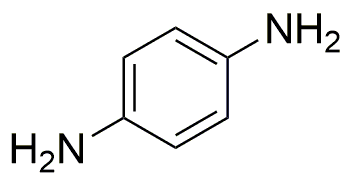1,4-Phenylenediamine is widely utilized in research focused on:
- Dye Manufacturing: This compound is a key ingredient in the production of azo dyes, which are used extensively in textiles, food, and cosmetics, providing vibrant colors and excellent stability.
- Polymer Chemistry: It serves as a hardener in epoxy resins, enhancing the durability and strength of materials used in construction and automotive industries.
- Pharmaceuticals: It is involved in the synthesis of various pharmaceutical compounds, contributing to the development of medications that treat a range of conditions.
- Cosmetics: Commonly found in hair dyes, it offers effective coloring properties while allowing for a wide range of shades, catering to diverse consumer preferences.
- Analytical Chemistry: Used as a reagent in various analytical techniques, it helps in the detection and quantification of certain metal ions, making it valuable in environmental testing and quality control.
General Information
Properties
Safety and Regulations
Applications
1,4-Phenylenediamine is widely utilized in research focused on:
- Dye Manufacturing: This compound is a key ingredient in the production of azo dyes, which are used extensively in textiles, food, and cosmetics, providing vibrant colors and excellent stability.
- Polymer Chemistry: It serves as a hardener in epoxy resins, enhancing the durability and strength of materials used in construction and automotive industries.
- Pharmaceuticals: It is involved in the synthesis of various pharmaceutical compounds, contributing to the development of medications that treat a range of conditions.
- Cosmetics: Commonly found in hair dyes, it offers effective coloring properties while allowing for a wide range of shades, catering to diverse consumer preferences.
- Analytical Chemistry: Used as a reagent in various analytical techniques, it helps in the detection and quantification of certain metal ions, making it valuable in environmental testing and quality control.
Documents
Safety Data Sheets (SDS)
The SDS provides comprehensive safety information on handling, storage, and disposal of the product.
Product Specification (PS)
The PS provides a comprehensive breakdown of the product’s properties, including chemical composition, physical state, purity, and storage requirements. It also details acceptable quality ranges and the product's intended applications.
Certificates of Analysis (COA)
Search for Certificates of Analysis (COA) by entering the products Lot Number. Lot and Batch Numbers can be found on a product’s label following the words ‘Lot’ or ‘Batch’.
Numéro de catalogue
Numéro de lot/série
Certificates Of Origin (COO)
This COO confirms the country where the product was manufactured, and also details the materials and components used in it and whether it is derived from natural, synthetic, or other specific sources. This certificate may be required for customs, trade, and regulatory compliance.
Numéro de catalogue
Numéro de lot/série
Safety Data Sheets (SDS)
The SDS provides comprehensive safety information on handling, storage, and disposal of the product.
DownloadProduct Specification (PS)
The PS provides a comprehensive breakdown of the product’s properties, including chemical composition, physical state, purity, and storage requirements. It also details acceptable quality ranges and the product's intended applications.
DownloadCertificates of Analysis (COA)
Search for Certificates of Analysis (COA) by entering the products Lot Number. Lot and Batch Numbers can be found on a product’s label following the words ‘Lot’ or ‘Batch’.
Numéro de catalogue
Numéro de lot/série
Certificates Of Origin (COO)
This COO confirms the country where the product was manufactured, and also details the materials and components used in it and whether it is derived from natural, synthetic, or other specific sources. This certificate may be required for customs, trade, and regulatory compliance.


